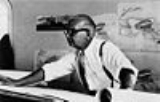
Carlos Raúl Villanueva
Encyclopedia
Carlos Raúl Villanueva was the most prominent Venezuela
n architect
of the 20th century and one of the great Modernist
s. He played a major role in the development and modernization of Caracas
, Maracay
and other cities across the country. Among his most important works are El Silencio Redevelopment which included 7,797 apartments and 207 shop premises and the Ciudad Universitaria
, the main campus of the Central University of Venezuela
, which is considered a masterpiece of modern city planning, architecture and art. The Campus was declared World Heritage Site
by UNESCO
in the year 2000 .
on May 30, 1900. He was the son of Carlos Antonio Villanueva and Paulina Astoul from a family originally from Valencia
, Spain
who settle in Venezuela
in the 18th century. His father was sent as an envoy from Venezuela to the Exposition Universelle
of 1889 in Paris
where he met Paulina Astoul and married her in 1893. A few years later, in 1896, he was appointed Consul
General of Venezuela in England
by the government of Joaquín Crespo
. Carlos Raúl was born four years later near the Venezuelan Consulate and was the youngest of the five children of the family. In the following years his family moved back to Paris, where he received his basic schooling at the Lycée Condorcet
. Later on he moved with his family to Málaga
, Spain, until 1919 when he returned to Paris. In 1922, following the footsteps of his brother Marcel, Carlos Raúl was admitted to the Second Class of the Department of Architecture
of the École des Beaux-Arts
and entered the workshop of Gabriel Héraud. In 1925 he entered the First Class of the Department of Architecture and worked closely with León Joseph Madeline. During that time he collaborated on a project for a Hôtel d'ambassade a construire dans un pays d'Extreme Orient with another student of Héraud's workshop, Roger-Leopold Hummel, which won the Second prize of the Grand Prix de Rome
in 1928. On June 6 of the same year, he received his Architecture
degree and traveled for the first time to Venezuela and the United States
where he joined the architectural firm Guilbert and Betelle
with his brother in Newark, New Jersey
. Yet in 1929 Villanueva returned to Venezuela and started working in the Ministry of Public Works as Director of Buildings and Ornamental Constructions.
. Both men shared a profound conviction that architecture was the art of organizing space. Consequently, Villanueva sees himself as a man of action and will work countless hours to fulfill his passion. His first jobs were on the city of Maracay
, a city which became the de facto capital of the country under General
Juan Vicente Gómez
. He received his first important assignment in 1929: the "Hotel Jardín". In his reform of the building it was possible to already observe some features that will become common in his designs. Among them were the use of covered galleries to provide protection from the weather and the use of interior courtyards and gardens to harmonize built and unbuilt spaces. On January 28, 1933, he married Margot Arismendi Amengual, a member of the prominent Venezuelan Arismendi
family, and had four children with her.
His first important commission came in 1935 with the project to build the Museum of Fine Arts of Caracas. This project allow him to create a space for the exhibition of art, one of his most important passions. Already at this time his devotion to the artistic vangards of the century could be seen in his library, where his large collection of books on architecture was complemented by those on art. It was also during this time that he met the sculptor Francisco Narváez with whom he collaborated in the Museum of Fine Arts as well as in a series of other important projects like the "Natural Science Museum"(1936–1939) and the "Gran Colombia School" (1939–1942) which became Villanueva's first attempt to bring into fruition the guiding principle of career: the synthesis of the arts. The buildings also showed Villanueva's application of some of the most defining ideas of modern architecture
like the simplification of form and the importance given to functionality.

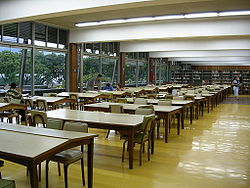 The Campus and buildings of the Universidad Central de Venezuela are considered to be Villanueva's masterwork. Built on the site of the old Hacienda
The Campus and buildings of the Universidad Central de Venezuela are considered to be Villanueva's masterwork. Built on the site of the old Hacienda
Ibarra - which originally belonged to Simon Bolívar
's family - and connected to the new city center around Plaza Venezuela, the project meant a massive undertaking of both urban planning and architectural design. The administration of Isaías Medina Angarita
bought the Hacienda Ibarra in 1942 in order to give the University a larger location than the San Francisco Covent, giving Villanueva a unique opportunity to applied his conscious integration of art and architecture on a grand scale. This vast urban complex of about 2 square kilometres includes a total of 40 buildings and it remains one of the most successful applications of Modern Architecture
in Latin America
. Villanueva worked closely with all the artists who contributed with their oeuvres and personally supervised the project for over 25 years until the late 60's when his deteriorating health forced him to leave some buildings in the design stage.

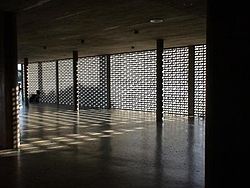
 In 1954, Villanueva described the guiding principle behind the Ciudad Universitaria in the following way:
In 1954, Villanueva described the guiding principle behind the Ciudad Universitaria in the following way:

.jpg)
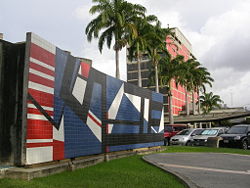
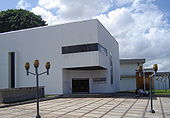
Venezuela
Venezuela , officially called the Bolivarian Republic of Venezuela , is a tropical country on the northern coast of South America. It borders Colombia to the west, Guyana to the east, and Brazil to the south...
n architect
Architect
An architect is a person trained in the planning, design and oversight of the construction of buildings. To practice architecture means to offer or render services in connection with the design and construction of a building, or group of buildings and the space within the site surrounding the...
of the 20th century and one of the great Modernist
Modern architecture
Modern architecture is generally characterized by simplification of form and creation of ornament from the structure and theme of the building. It is a term applied to an overarching movement, with its exact definition and scope varying widely...
s. He played a major role in the development and modernization of Caracas
Caracas
Caracas , officially Santiago de León de Caracas, is the capital and largest city of Venezuela; natives or residents are known as Caraquenians in English . It is located in the northern part of the country, following the contours of the narrow Caracas Valley on the Venezuelan coastal mountain range...
, Maracay
Maracay
Maracay is a city in north-central Venezuela, near the Caribbean coast, and is the capital and most important city of the state of Aragua. Most of it falls under the jurisdiction of the Girardot Municipality. The population as per the 2001 census was 750,000...
and other cities across the country. Among his most important works are El Silencio Redevelopment which included 7,797 apartments and 207 shop premises and the Ciudad Universitaria
Ciudad Universitaria de Caracas
The University City of Caracas is the main Campus of the Central University of Venezuela. It was designed by the Venezuelan architect Carlos Raúl Villanueva and was declared a World Heritage Site by UNESCO in 2000...
, the main campus of the Central University of Venezuela
Central University of Venezuela
The Central University of Venezuela is a premier public University of Venezuela located in Caracas...
, which is considered a masterpiece of modern city planning, architecture and art. The Campus was declared World Heritage Site
World Heritage Site
A UNESCO World Heritage Site is a place that is listed by the UNESCO as of special cultural or physical significance...
by UNESCO
UNESCO
The United Nations Educational, Scientific and Cultural Organization is a specialized agency of the United Nations...
in the year 2000 .
Early life and education (1900-1928)
Villanueva was born in the city of LondonLondon
London is the capital city of :England and the :United Kingdom, the largest metropolitan area in the United Kingdom, and the largest urban zone in the European Union by most measures. Located on the River Thames, London has been a major settlement for two millennia, its history going back to its...
on May 30, 1900. He was the son of Carlos Antonio Villanueva and Paulina Astoul from a family originally from Valencia
Valencia (city in Spain)
Valencia or València is the capital and most populous city of the autonomous community of Valencia and the third largest city in Spain, with a population of 809,267 in 2010. It is the 15th-most populous municipality in the European Union...
, Spain
Spain
Spain , officially the Kingdom of Spain languages]] under the European Charter for Regional or Minority Languages. In each of these, Spain's official name is as follows:;;;;;;), is a country and member state of the European Union located in southwestern Europe on the Iberian Peninsula...
who settle in Venezuela
Venezuela
Venezuela , officially called the Bolivarian Republic of Venezuela , is a tropical country on the northern coast of South America. It borders Colombia to the west, Guyana to the east, and Brazil to the south...
in the 18th century. His father was sent as an envoy from Venezuela to the Exposition Universelle
Exposition Universelle (1889)
The Exposition Universelle of 1889 was a World's Fair held in Paris, France from 6 May to 31 October 1889.It was held during the year of the 100th anniversary of the storming of the Bastille, an event traditionally considered as the symbol for the beginning of the French Revolution...
of 1889 in Paris
Paris
Paris is the capital and largest city in France, situated on the river Seine, in northern France, at the heart of the Île-de-France region...
where he met Paulina Astoul and married her in 1893. A few years later, in 1896, he was appointed Consul
Consul
Consul was the highest elected office of the Roman Republic and an appointive office under the Empire. The title was also used in other city states and also revived in modern states, notably in the First French Republic...
General of Venezuela in England
England
England is a country that is part of the United Kingdom. It shares land borders with Scotland to the north and Wales to the west; the Irish Sea is to the north west, the Celtic Sea to the south west, with the North Sea to the east and the English Channel to the south separating it from continental...
by the government of Joaquín Crespo
Joaquín Crespo
Joaquín Sinforiano de Jesús Crespo Torres was a politician, soldier, a member of the Great Liberal Party of Venezuela and President of Venezuela from 1884 to 1886 and again from 1892 to 1898...
. Carlos Raúl was born four years later near the Venezuelan Consulate and was the youngest of the five children of the family. In the following years his family moved back to Paris, where he received his basic schooling at the Lycée Condorcet
Lycée Condorcet
The Lycée Condorcet is a school founded in 1803 in Paris, France, located at 8, rue du Havre, in the city's IXe arrondissement. Since its inception, various political eras have seen it given a number of different names, but its identity today honors the memory of the Marquis de Condorcet. The...
. Later on he moved with his family to Málaga
Málaga
Málaga is a city and a municipality in the Autonomous Community of Andalusia, Spain. With a population of 568,507 in 2010, it is the second most populous city of Andalusia and the sixth largest in Spain. This is the southernmost large city in Europe...
, Spain, until 1919 when he returned to Paris. In 1922, following the footsteps of his brother Marcel, Carlos Raúl was admitted to the Second Class of the Department of Architecture
Architecture
Architecture is both the process and product of planning, designing and construction. Architectural works, in the material form of buildings, are often perceived as cultural and political symbols and as works of art...
of the École des Beaux-Arts
École des Beaux-Arts
École des Beaux-Arts refers to a number of influential art schools in France. The most famous is the École nationale supérieure des Beaux-Arts, now located on the left bank in Paris, across the Seine from the Louvre, in the 6th arrondissement. The school has a history spanning more than 350 years,...
and entered the workshop of Gabriel Héraud. In 1925 he entered the First Class of the Department of Architecture and worked closely with León Joseph Madeline. During that time he collaborated on a project for a Hôtel d'ambassade a construire dans un pays d'Extreme Orient with another student of Héraud's workshop, Roger-Leopold Hummel, which won the Second prize of the Grand Prix de Rome
Prix de Rome
The Prix de Rome was a scholarship for arts students, principally of painting, sculpture, and architecture. It was created, initially for painters and sculptors, in 1663 in France during the reign of Louis XIV. It was an annual bursary for promising artists having proved their talents by...
in 1928. On June 6 of the same year, he received his Architecture
Architecture
Architecture is both the process and product of planning, designing and construction. Architectural works, in the material form of buildings, are often perceived as cultural and political symbols and as works of art...
degree and traveled for the first time to Venezuela and the United States
United States
The United States of America is a federal constitutional republic comprising fifty states and a federal district...
where he joined the architectural firm Guilbert and Betelle
Guilbert and Betelle
Guilbert and Betelle was an architecture firm formed as a partnership of Ernest F. Guilbert and James Oscar Betelle. The firm specialized in design of schools on the East Coast of the United States, with an emphasis on the "Collegiate Gothic" style....
with his brother in Newark, New Jersey
Newark, New Jersey
Newark is the largest city in the American state of New Jersey, and the seat of Essex County. As of the 2010 United States Census, Newark had a population of 277,140, maintaining its status as the largest municipality in New Jersey. It is the 68th largest city in the U.S...
. Yet in 1929 Villanueva returned to Venezuela and started working in the Ministry of Public Works as Director of Buildings and Ornamental Constructions.
First Modernism (1929-1944)
After gaining some experience in France and the United States, Villanueva arrives in Venezuela full of enthusiasm and ideas; in particular, thanks to the influence of his close friend Auguste PerretAuguste Perret
Auguste Perret was a French architect and a world leader and specialist in reinforced concrete construction. In 2005 his post-WWII reconstruction of Le Havre was declared by UNESCO one of the World Heritage Sites....
. Both men shared a profound conviction that architecture was the art of organizing space. Consequently, Villanueva sees himself as a man of action and will work countless hours to fulfill his passion. His first jobs were on the city of Maracay
Maracay
Maracay is a city in north-central Venezuela, near the Caribbean coast, and is the capital and most important city of the state of Aragua. Most of it falls under the jurisdiction of the Girardot Municipality. The population as per the 2001 census was 750,000...
, a city which became the de facto capital of the country under General
General
A general officer is an officer of high military rank, usually in the army, and in some nations, the air force. The term is widely used by many nations of the world, and when a country uses a different term, there is an equivalent title given....
Juan Vicente Gómez
Juan Vicente Gómez
Juan Vicente Gómez Chacón was a military general and de facto ruler of Venezuela from 1908 until his death in 1935. He was president on three occasions during this time, and ruled as an unelected military strongman for the rest of the era.-Early years:Gómez was a barely literate cattle herder and...
. He received his first important assignment in 1929: the "Hotel Jardín". In his reform of the building it was possible to already observe some features that will become common in his designs. Among them were the use of covered galleries to provide protection from the weather and the use of interior courtyards and gardens to harmonize built and unbuilt spaces. On January 28, 1933, he married Margot Arismendi Amengual, a member of the prominent Venezuelan Arismendi
Arismendi (Surname)
Arismendi is a Basque surname. The Basque people are indigenous to the area of northeast Spain and southwest France, a historical region known as the Basque Country. Arismendi means "mountain of oaks"; aris meaning "oak" and mendi meaning "mountain."...
family, and had four children with her.
His first important commission came in 1935 with the project to build the Museum of Fine Arts of Caracas. This project allow him to create a space for the exhibition of art, one of his most important passions. Already at this time his devotion to the artistic vangards of the century could be seen in his library, where his large collection of books on architecture was complemented by those on art. It was also during this time that he met the sculptor Francisco Narváez with whom he collaborated in the Museum of Fine Arts as well as in a series of other important projects like the "Natural Science Museum"(1936–1939) and the "Gran Colombia School" (1939–1942) which became Villanueva's first attempt to bring into fruition the guiding principle of career: the synthesis of the arts. The buildings also showed Villanueva's application of some of the most defining ideas of modern architecture
Modern architecture
Modern architecture is generally characterized by simplification of form and creation of ornament from the structure and theme of the building. It is a term applied to an overarching movement, with its exact definition and scope varying widely...
like the simplification of form and the importance given to functionality.
Ciudad Universitaria (1944-1970)


Hacienda
Hacienda is a Spanish word for an estate. Some haciendas were plantations, mines, or even business factories. Many haciendas combined these productive activities...
Ibarra - which originally belonged to Simon Bolívar
Simón Bolívar
Simón José Antonio de la Santísima Trinidad Bolívar y Palacios Ponte y Yeiter, commonly known as Simón Bolívar was a Venezuelan military and political leader...
's family - and connected to the new city center around Plaza Venezuela, the project meant a massive undertaking of both urban planning and architectural design. The administration of Isaías Medina Angarita
Isaías Medina Angarita
Isaías Medina Angarita was a Venezuelan military and political leader, president of Venezuela from 1941 until 1945....
bought the Hacienda Ibarra in 1942 in order to give the University a larger location than the San Francisco Covent, giving Villanueva a unique opportunity to applied his conscious integration of art and architecture on a grand scale. This vast urban complex of about 2 square kilometres includes a total of 40 buildings and it remains one of the most successful applications of Modern Architecture
Modern architecture
Modern architecture is generally characterized by simplification of form and creation of ornament from the structure and theme of the building. It is a term applied to an overarching movement, with its exact definition and scope varying widely...
in Latin America
Latin America
Latin America is a region of the Americas where Romance languages – particularly Spanish and Portuguese, and variably French – are primarily spoken. Latin America has an area of approximately 21,069,500 km² , almost 3.9% of the Earth's surface or 14.1% of its land surface area...
. Villanueva worked closely with all the artists who contributed with their oeuvres and personally supervised the project for over 25 years until the late 60's when his deteriorating health forced him to leave some buildings in the design stage.
Artists who contributed in the Project


- Jean ArpJean ArpJean Arp / Hans Arp was a German-French, or Alsatian, sculptor, painter, poet and abstract artist in other media such as torn and pasted paper....
- André BlocAndré BlocAndré Bloc was a French architect, sculptor, editor, and founder of several specialist journals. He founded the "Groupe Espace" in 1949....
- Alexander CalderAlexander CalderAlexander Calder was an American sculptor and artist most famous for inventing mobile sculptures. In addition to mobile and stable sculpture, Alexander Calder also created paintings, lithographs, toys, tapestry, jewelry and household objects.-Childhood:Alexander "Sandy" Calder was born in Lawnton,...
- Wifredo LamWifredo LamWifredo Óscar de la Concepción Lam y Castilla , better known as Wifredo Lam, was a Cuban artist who sought to portray and revive the enduring Afro-Cuban spirit and culture...
- Henri LaurensHenri LaurensHenri Laurens was a French sculptor and illustrator.-Early life and education:Born in Paris, Henri Laurens worked as a stonemason before he became a sculptor...
- Fernand LégerFernand LégerJoseph Fernand Henri Léger was a French painter, sculptor, and filmmaker. In his early works he created a personal form of Cubism which he gradually modified into a more figurative, populist style...
- Baltasar LoboBaltasar LoboBaltasar Lobo was a Spanish artist, anarchist and sculptor best known for his compositions depicting mother and child.-Life:...
- Antoine PevsnerAntoine PevsnerAntoine Pevsner was a Belarusian and Russian sculptor and the older brother of Alexii Pevsner and Naum Gabo. Both Antoine and Naum are considered pioneers of twentieth-century sculpture.Pevsner was born in Klimavichy, Belarus...
- Sophie Taeuber-ArpSophie Taeuber-ArpSophie Taeuber-Arp was a Swiss artist, painter and sculptor. Born in Davos, Switzerland, Sophie Täuber began her art studies in her homeland, at the School of Applied Arts in St. Gallen...
- Victor VasarelyVictor VasarelyVictor Vasarely was a Hungarian French artist whose work is generally seen aligned with Op-art.His work entitled Zebra, created by Vasarely in the 1930s, is considered by some to be one of the earliest examples of Op-art...
- Miguel Arroyo
- Armando Barrios
- Omar Carreño
- Carlos González Bogen
- Pedro León Castro
- Mateo Manaure
- Francisco NarváezFrancisco NarváezVenezuela's most important sculptor by popular acclamation, Francisco Narváez inaugurated his country's age of modernism at the start of the 1930s, returning from three years in Paris and instantly catalyzing the national culture...
- Pascual Navarro
- Alirio Oramas
- Alejandro OteroAlejandro OteroAlejandro Otero was a Venezuelan artist, writer and cultural promoter.He studied at the "Escuela de Artes Plásticas y Artes Aplicadas de Caracas" from 1939 to 1945...
- Héctor Poleo
- Braulio Salazar
- Jesús-Rafael Soto
- Víctor Valera
- Oswaldo Vigas
Synthesis of the arts

1920s
- Banco Obrero and Banco Agrícola y Pecuario (Plaza Guirardot - Maracay, 1929)
- Jardín Hotel (Plaza Bolívar - Maracay, 1929–1930)
1930s

.jpg)
- Sports Club (Maracay, 1930)
- Plaza Bolívar (Maracay, 1930–1935)
- "La Maestranza" Bullring (Maracay, 1931–1932)
- Bolivarian Museum (Caracas, 1931)
- Mental Hospital (Caracas, 1931–1933)
- Plaza Carabobo (Caracas, 1934)
- Museum of Fine Arts (Caracas, 1935–1938)
- Museum of Natural Sciences (Caracas, 1934–1935)
- Venezuelan Pabillion at the Paris Exposition (Paris, France, 1937 - Demolished)
- Simón Bolívar Plaza (Valparaíso, Chile, 1938)
- Los Rosales and El Prado Residential States (Caracas, 1938–1940)
- Gran Colombia School (Caracas, 1939–1942); (currently the Francisco Pimentel School).
1940s

- Headquarters of the Venezuelan Chamber of Commerce (Caracas, 1940)
- La Concordia Plaza (1940)
- Buena Vista Preorientation Boarding School (Los Teques, 1940–1942)
- Passenger Terminal (Valera, 1941–1942)
- El Silencio Redevelopment (Caracas, 1941–1945)
- Radio Communications Building (Caracas, 1943)
- General Rafael Urdaneta Development (Maracaibo, 1943)
- Unidad Vacacional Los Caracas (1944)
- Ciudad Universitaria de CaracasCiudad Universitaria de CaracasThe University City of Caracas is the main Campus of the Central University of Venezuela. It was designed by the Venezuelan architect Carlos Raúl Villanueva and was declared a World Heritage Site by UNESCO in 2000...
- Campus of the Central University of VenezuelaCentral University of VenezuelaThe Central University of Venezuela is a premier public University of Venezuela located in Caracas...
(1944–1970) - Rafael Urdaneta Plaza (Caracas, 1945)
- University Hospital (Caracas, 1945)
- Anatomical Institute (Caracas, 1945)
- Rafael Urbaneta School (Maracaibo, 1945–1946)
- El Hipódromo Development (Maracay, 1946)
- Las Delicias Neighborhood Unit (Maracay, 1948–1952)
1950s
- Hacienda La Pimpera House (Barlovento, 1954)
- Diego de Losada Development (Caracas, 1954)
- Atlántico Norte Development (Caracas, 1954–1955)
- Lomas de Pro Patria (Caracas, 1954)
- Cotiza Housing Estate (Caracas, 1954)
- Artigas Residential Estate (Caracas, 1954–1955)
- La Vega Residential Estate (Caracas, 1955)
- 23 de Enero Development (Caracas, 1955–1957)
- Simón Rodríguez Development (Caracas, 1956)
- Altos de Curia Residential Estate (Caracas, 1954)
- School of Petroleum Engineering (Maracaibo, 1956)

1960s
- La Salle Foundation (1961–1962)
- Caomita House (Caracas, 1962)
- House for Alejandro Otero (San Antonio de Los Altos, 1965)
- Plaza Estrella Building (Caracas, 1964)
- Venezuelan Pavilion for the Montreal Expo (Montreal, Canada, 1967)

